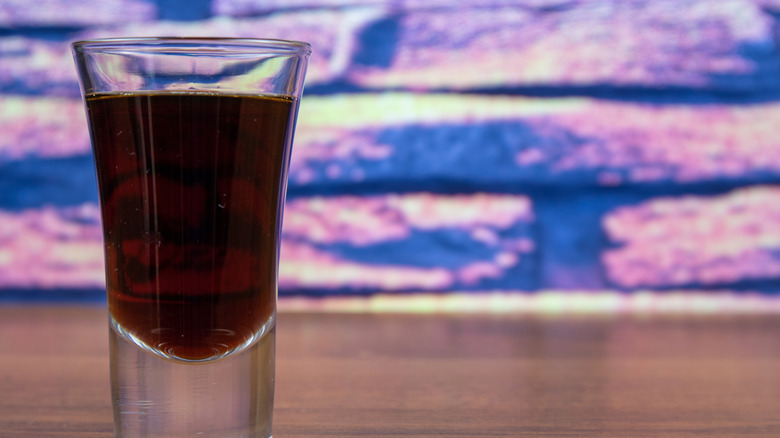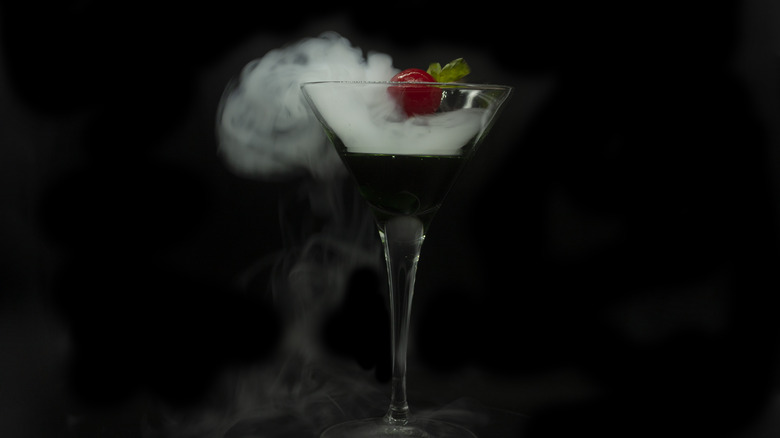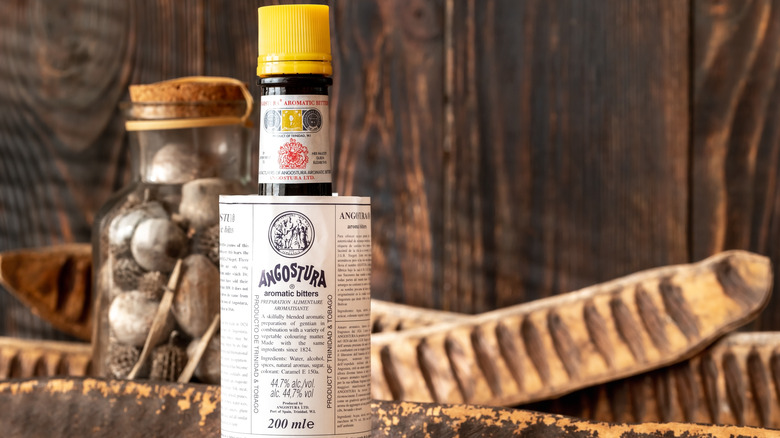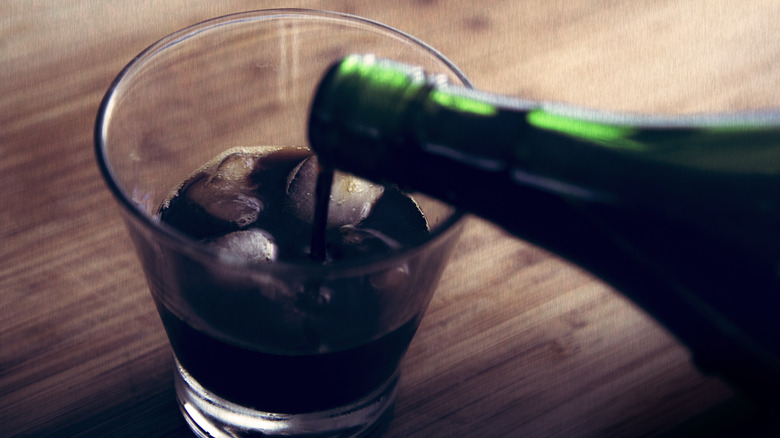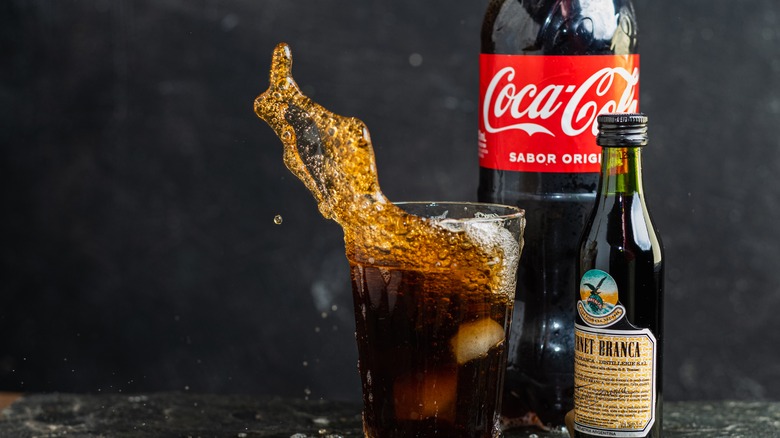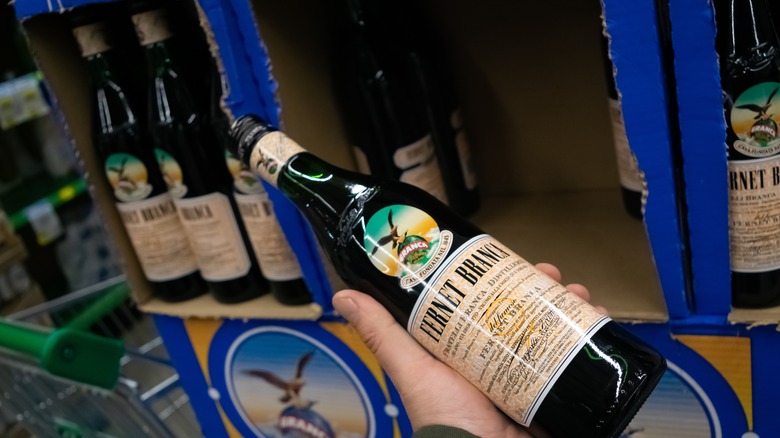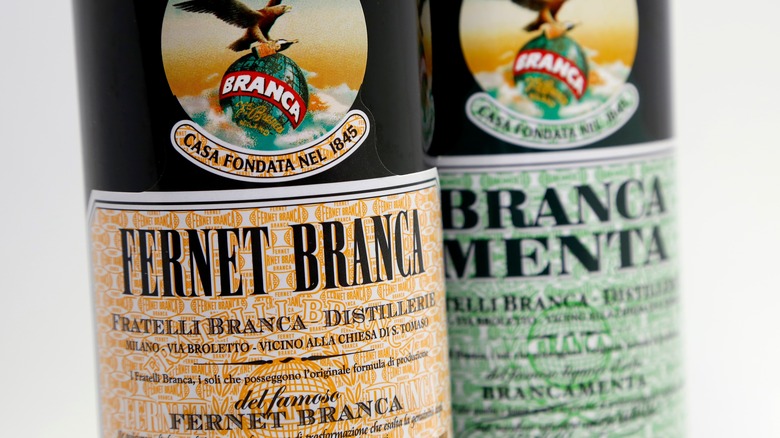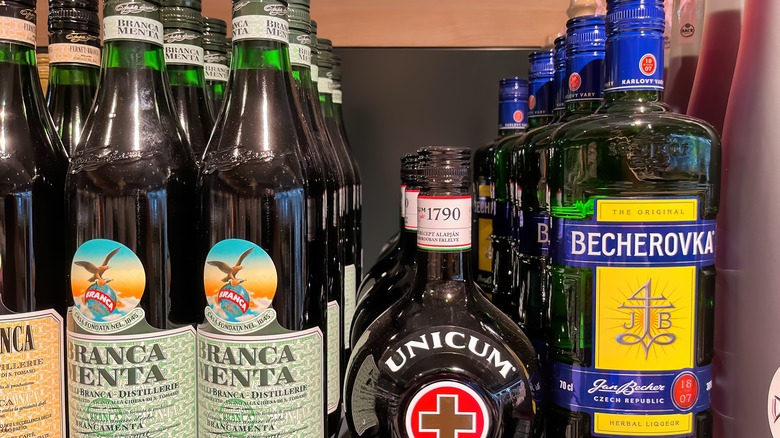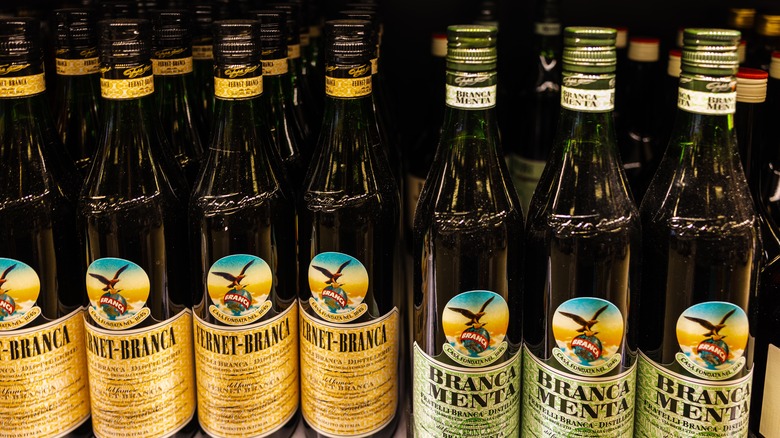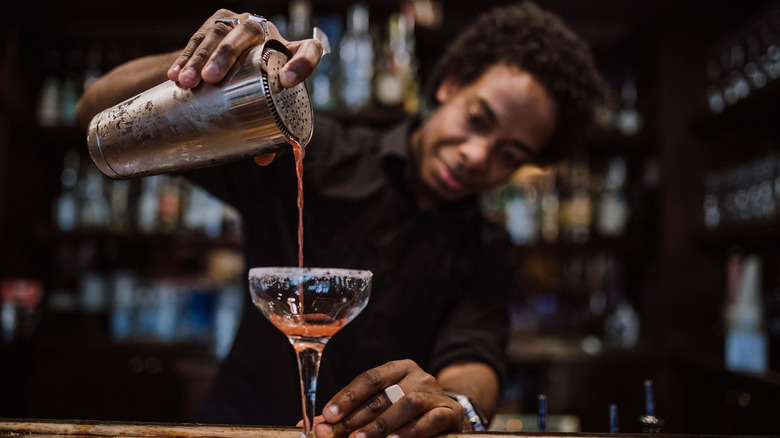Fernet Is The Herbal Liqueur That's A Bartender's Best Friend
Fernet is an Italian amaro, or herbal liqueur, and is one of the best-kept secrets of the bartending trade. You'll most often find fernet added to cocktails to boost bitter flavors and balance sweetness, but you can also drink it as a shot or on the rocks. Fernet has a fascinating history, originating in Europe and thriving during the prohibition era in the US. In San Francisco in the early 2000s, ordering a fernet became known as the "bartender's handshake" — a signal to other industry professionals that you were one of them and that you knew your way around a mixology table.
So, what does fernet taste like, and does it live up to the hype as a sophisticated tipple for those in the know? Well, that depends on how you like your liquor. Strong bitter flavors combined with an abrasive minty tint give fernet a reputation as a mouth-burner that can take some getting used to. Connoisseurs, however, rate it for its complex flavor profile and depth and even credit its digestive effects.
To find out more about fernet, we decided to consult an expert ourselves. We chatted with John O'Brien, Bar Manager at TLK, a health-conscious, gluten-free Hong Kong-influenced restaurant that serves cocktails in New York City. He gave us the industry low-down on this mysterious spirit and how it can be used behind the bar.
What is fernet?
Originating in Milan, Italy, in the mid-1800s, Fernet is an alcoholic liquor made by mixing herbs, roots, and spices with neutral grain spirit. Fernet is categorized as a type of Italian amaro, otherwise known as Italian bitters, and is one of the strongest amari that you can buy. Like other amari, such as Aperol and Cynar, fernet is an aperitif or digestivo – a liqueur enjoyed before or after a meal to help digestion — but is also a common ingredient in cocktails that's used to enhance flavor. Amazingly, when fernet was first invented, it was marketed as a cholera tonic.
Fernet-Branca, one of the most famous fernet brands available today, began life in Milan in the 1840s at the Fratelli Branca distillery. The drink then became popular in South America — particularly Argentina — when European immigrants moved there in the late 1800s. Fernet has a high ABV and is usually around 30 to 45%. Despite this and due to the perception that it had medicinal qualities, fernet escaped the U.S. Prohibition ban and was still sold in American pharmacies during this period.
Today, fernet is still found behind bars, mainly used as flavoring bitters and added to cocktails. According to John O'Brien, "Fernet is quite versatile. It can balance a cocktail by adding bitter and herbal notes when needed. And enjoyed on its own, it provides a digestive aid after a large meal."
Why do bartenders love fernet?
As John O'Brien notes, fernet's versatility is a big reason for its popularity among bartenders. While he observes that he has "seen some strange things done with fernet," there are generally "no mistakes" when working using the amaro. In high-end cocktail bars, you'll find a variety of drinks that contain a dash of fernet. It may be imperceptible and just there to amp up the other flavors or to add a peppermint taste.
Another reason for Fernet's popularity comes from its association with the early 2000s bar scene when craft cocktails began to experience a cultural resurgence, especially in cities like New York and San Francisco. Usually sold in a brown glass bottle, fernet was kept behind most cocktail bars but was rarely ordered, so would sit on the counter for months. This led to fernet's reputation as a drink for bartenders and catering professionals, who would reportedly take a shot of fernet at the end of their shift just as their replacement came on. This became known as the aforementioned "bartender handshake."
Fernet-Branca even issued an official coin in 2013 that was given out to long-standing bartenders to symbolize their membership in this elite community. The coin could be used to purchase a shot of Fernet-Branca and is part of various industry drinking games.
How is fernet made?
Fernet's herbaceous taste comes from steeping botanical roots, herbs, and spices in neutral grain alcohol. This infusion can be performed either through hot or cold methods, including stirring with a hot iron bar, which is noted as one of the original techniques for making Fernet-Branca. After this, the mixture is left for around one month and then aged in oak barrels.
The original Milanese fernet recipe is not known, but it is believed to include at least 27 to 40 different herbs from all over the world. These herbs include black aloe ferox, chamomile, mint, rhubarb roots, cardamom, bitter orange, and saffron, and many are believed to have healing properties and are used in holistic medicine.
With so many herbs and spices worked into the mix, the flavors merge to create a sophisticated and aromatic liqueur that can be enjoyed on its own or used to highlight other tastes. John O'Brien states his preference for using fernet to balance sweet and tart flavors. "Deep sweetness of berries and molasses-like flavor profiles tend to shine with fernet, balancing out the bitter notes."
Fernet versus Angostura Bitters
As well as Italian amari, there are several other cocktail bitters that bartenders use to mix cocktails. Angostura bitters, for example, are a spicy herb and alcohol blend that hails from Trinidad and Tobago. They're used by bartenders to give Bloody Marys a kick and to bring out the sweetness in the tomato juice. Other cocktail recipes, like for a Manhattan or an Old Fashioned, are often enhanced with a few drops of Angostura's Bitters, which have a spicy umami flavor.
Unlike Fernet, however, you cannot consume Angostura Bitters as a shot or drink by itself. Angostura is used more like a seasoning for drinks and must be added with care and to the customer's taste. If overused, these bitters can make cocktails eye-watering and undrinkable, although some punchier cocktails call for a slightly larger slug.
Like fernet, Angostura is around 35 to 45% ABV, but its alcoholic effect is limited because you don't consume much of it in a cocktail. While both are used as a flavoring agent, John O'Brien notes that "really there is no close substitute for the flavor profile of fernet." Angostura also lacks fernet's minty overtones.
What does fernet taste like?
Neat fernet has a unique, bitter flavor that can make it unapproachable for casual drinkers. However, if you like a liqueur that challenges the palette, it is worth persevering with. On the first try, you may find fernet's bitterness overwhelming. However, underneath this, there is a herbaceous, minty, and mulchy flavor that is prized among the bar community for its complexity.
When you start to savor fernet's many flavors, you can find licorice notes and hints of chicory. Customers also note that fernet has earthy, root-like flavors, similar to dark chocolate or coffee, and mingled with pine. Fernet has a dry mouthfeel because of its high tannins. Compared with other brands, American-made Fernet-Branca is considered to be one of the mintiest on the market. In cocktails, Fernet mixes well to balance and elevate other flavors. John O'Brien observes that "deep sweetness" in drinks often complements fernet's natural bitterness. Think black coffee and demerara sugar or dark chocolate with raspberries.
How to mix drinks with Fernet
If you want to drink fernet like an Italian, you'll drink a straight measure at room temperature. It's also traditionally consumed in Italy after a big meal and "provides a digestive aid," according to John O'Brien. One of the most common fernet cocktails is the Hanky Panky, which is mentioned in Charles H. Baker Jr's 1939 cocktail recipe book, "The Gentleman's Companion." A traditional Hanky Panky is made with gin, sweet vermouth, and Fernet-Branca strained over ice and garnished with an orange peel twist.
Fernet is also popularly used to brighten up a Manhattan — made with rye, vermouth, bitters, mint, and orange — or a whiskey and orange Old Fashioned. If you want a slightly lighter option, you could try a Fernet-Branca Spritz — fresh orange juice spiked with Fernet-Branca and topped up with Prosecco or champagne. Another famous option is the Decolletage, which is a mix of reposado tequila, Aperol, Dubonnet Rouge, and Fernet-Branca.
In Argentina, Fernet con Cola — fernet mixed into Coca-Cola — is extremely popular and is the country's unofficial national drink. Meanwhile, in the U.K. and the U.S., fernet and ginger beer are a niche but not unknown combo.
Where to buy fernet?
To buy fernet or Fernet-Branca, you will usually need to visit a specialist wine shop or alcohol retailer. Not many supermarkets sell fernet, although it's worth checking the alcohol aisle in Lidl, which is known to sell the amaro throughout Europe. Most online retailers, like Sam Liquor Store or Blackwell's Wines & Spirits, sell Fernet-Branca for around $35 to $45, which is the standard price.
You can also purchase Fernet-Branca on Amazon for around the same price. Other, more specialized types of fernet, like Tempus Fugit Fernet del Frate Angelico, are also available on Amazon but are generally more expensive. A bottle of this maker's version of fernet will set you back around $65 to $75.
For other types of fernet, aside from Fernet-Branca, you can expect to pay in the range of $20 to $60 for a bottle. If you're ordering a fernet cocktail in a bar in New York City, you're likely to pay $18 to $20. This pricey tag isn't down to the fernet specifically — that's just what an average cocktail bar charges in NYC. Meanwhile, in San Francisco, a fernet cocktail will set you back around $17.
Nutritional information about fernet
Like many other high-ABV drinks, fernet is surprisingly high in calories, clocking in at between 130 to 140 per serving. This is due to alcohol content rather than sugar content — fernet is low in carbohydrates compared with many other spirits and bitters. Most of the herbs used in fernet are associated with medicinal properties. For example, cinchona officinale is believed to act as an anti-inflammatory, while rhubarb root is believed to soothe digestion.
Given its potent herbal quality, fernet is also sometimes consumed as a hangover cure and is considered a digestif in Italy. While there isn't much evidence to suggest that fernet has a huge nutritional value, it is believed to cleanse the palette and make you feel more awake and alert after a large meal. Fernet also contains large quantities of saffron, which is high in Vitamin A and is supposed to boost energy. However, the amounts of any vitamin in the liqueur are incredibly trace.
Varieties of fernet
While Fernet-Branca is often the brand stocked behind U.S. bars, fernet actually refers to a whole category of amari, or Italian bitters. Fernet has a high ABV compared with most bitters and is less sweet than other amari, like Campari or Amaro Montenegro. Despite this, you can still find fernets that are slightly sweeter than Fernet-Branca, which has a distinctly strong mint flavor. For example, Fernet Leopold emphasizes the red berry notes to create a milder, sweeter effect, while Salmiakki Dala Fernet from Iceland has a more flowery, botanical profile.
The oldest Fernet brand in existence is Fernet Vittone, which was originally produced in 1842 and is still sold today. Like Fernet-Branca, Fernet Vittone has a vintage label and a minty and bitter taste but with a slightly thinner texture.
The huge variety of flavors found in fernet, even with only relatively few types on the market, is one of the main reasons for its popularity among bar staff and mixologists. As John O'Brien explains, "It speaks to fernet's versatility and appeal that people are willing to try bizarre things with it." Despite its somewhat niche qualities, "if it's received well by someone, it has a place."
How to store fernet
Fernet can be enjoyed chilled, over ice, or at room temperature. You don't need to keep it in the fridge, but you should store it out of direct sunlight as exposure to heat can water down the flavor. Like other syrupy and high ABV liqueurs, a bottle of fernet will keep for around 6 months or even longer after opening because the high alcohol content prevents spoiling. This is why you'll often find bottles of mysterious and widely unknown spirits hanging around on bar counters, seemingly unused.
Fernet also has a low sugar content, which stops excessive bacterial growth and prolongs the liqueur's shelf life after opening. Although it will still be safe to consume after this, exposure to the air may alter the flavor and you should always check the label on your particular bottle for any expiry instructions. If you've got an unopened fernet bottle at home that you haven't got around to drinking yet, don't worry. When the bottle is still sealed, fernet has an indefinite shelf life.
What can you use instead of fernet?
Fernet has a unique flavor profile, and varying fernet types may have very different tastes depending on the herbs used and the specific aging process. That said, the earthy bitterness and minty spice of this amaro are distinctive and are hard to replicate, even within the broader amari category. As a cocktail ingredient, some amari bitters can do a similar job, although most other amari are sweeter and do not have the mentholic, terraceous flavors so recognizable in traditional fernet. This gives fernet a truly original place in the world of cocktail techniques and professional mixology.
John O'Brien backs up the idea that fernet is a one-of-a-kind drink. "If fernet is unavailable, there are some liquors that I might try to substitute, like Montenegro, Cynar, Chartreuse, or maybe even Suze, depending on what I need, he said. "But, really, there is no close substitute for the flavor profile of fernet."
